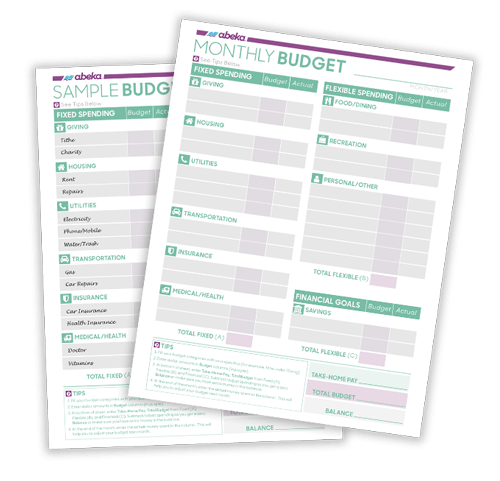Budgets are a sour subject for most of us.
Now they’re easy to set. . . but life happens—a tire blows out, someone has a birthday, and before you know it, you’re in over your head with bills. So we set budgets. But really that’s not quite enough, is it? A lot of broke people have budgets. You have to follow a budget for it to work.
Here are some ideas to help you plan a budget and stick to it!

Define your needs.
Everyone has a different idea of what they need.
People say everything from “I need to take my vitamins” and “I need to organize that drawer” to “I just need a back rub” or “what I really need right now is some dark chocolate.” Maybe we just overuse the word.
But when it comes to budgeting, you can start just by narrowing down what the family really does need and differentiating that from what everyone wants. Once you can separate the two and make sure you are budgeting for the “needs,” you’ll be able to have a little extra for the “wants.”
Use the envelope system.
 If you’re a paper kind of mom, this may be for you! The idea here is that you sit down at the beginning of the month and label envelopes for each spending category. Pull out the hard cash for each of those categories—then the rest you can save.
If you’re a paper kind of mom, this may be for you! The idea here is that you sit down at the beginning of the month and label envelopes for each spending category. Pull out the hard cash for each of those categories—then the rest you can save.
If you prefer, of course, you can use a digital envelope system instead of paper envelopes with cash.
This system especially helps when you’re on a tight budget. You can’t spend more than you have, because once it’s gone, it’s gone.
And whether you decide to use the envelope system or not, try this free printable budgeting template (pictured above) for organizing your spending!
Budget by percentages.
Try the 50/20/30 guideline (https://www.learnvest.com/knowledge-center/your-ultimate-budget-guideline-the-502030-rule/). This breaks down your money into categories instead of flat dollar amounts. Basically, 50% goes to fixed costs, 20% to financial goals, and 30% to flexible spending.
This is great if you’d rather channel your money into just a few basic groups instead of specific ones.
Find the areas where you can save.
You know those $5, $10, $30 dollar trips out. Maybe it’s just coffee, craft supplies, and a quick run through the department store—but when it’s not in the budget, it adds up fast. Be intentional with how you spend!
Most people would tell you they aren’t loaded—but only 1 in 3 Americans even bother with a budget. So plan out your grocery trips and errands. Research the best times of the year to go clothes-shopping. Swap a weekend trip to Disney for a weekend camping trip!
Just being intentional could save you hundreds each month.
Plan for the holidays.

Speaking of spending intentionally, nothing drains your money like a holiday season. Trimming the tree, trimming the turkey, presents, parties, and oh, did we already mention vacations?
The key here is planning. Put a spot in your budget for holidays. Decide ahead of time how you’ll be spending—who are you giving gifts to? What will your price range be for each person? Put the details of your holiday on a timeline so you know what’s coming—the travel plans, festive parties, and big family meals.
Then start an account where you put your holiday savings, and don’t touch it until the festivities roll around.
Earn some money on the side.
Try being proactive with your budget, and find the ways you can earn. Online businesses are a HUGE industry right now—especially for moms! Blogs, crafts, photography, or even translation work. Find your niche, then see if you can make it into a small side job.
Or have you ever heard of getting paid to test websites or take online surveys? You can make some extra money without even interrupting your daily schedule.
Pass it on.
If you do allowance with the kids, teach them a basic budget for what they earn! Or if you have teens just starting out with a job, walk them through your own budget and suggest they try something similar.
Teaching them how to spend money wisely now will build habits to last into adulthood!
And finally, give yourself a break.

Have a day where the family goes out for dinner, or maybe just out for ice cream. If money is tight, go on a picnic and bring “special groceries.”
Don’t let “We have no money” be the answer to every activity your kids suggest. Let them know, “Maybe later”; “We’ll save up”; OR “Sweetie, instead let’s try _______.”
And try some of these affordable activities for the family when you run out of your own ideas.
It’s like exercise, cleaning the house, or just cleaning out your purse—a little planning and elbow grease can go a long way.

High school juniors and seniors learn budgeting skills and more through our Family and Consumer Sciences elective.
SHOP NOW



Comments for Budget Management
Add A Comment
Your email address will not be published. Required fields are marked *